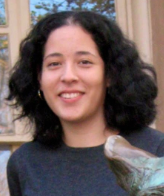Seven undergraduates have been awarded research funds from the Peter B. Lewis Fund for Student Innovation in Energy and the Environment and the Dede T. Bartlett P03 Fund for Student Research in Energy and the Environment. This competitive funding supports undergraduate research on energy- and environment-related projects, particularly field work and laboratory research. The recipients will spend eight weeks this summer working under the guidance of a faculty advisor. The students’ projects, described below, are aimed at providing solutions to energy- and environment-related challenges.
Five students were awarded funding for research in the summer of 2013.
[clear]
 Melina Acevedo ’16
Melina Acevedo ’16
(Faculty Advisor – Andrew Bocarsly, Chemistry)
Title: An Investigation of Bismuth as a Novel Electrocatalyst for the Reduction of Carbon Dioxide
Abstract: The objective of this work is to gain a mechanistic understanding of the influence of electrode morphology on the electrochemical performance of a bismuth cathode in the reduction of carbon dioxide to formic acid and the competing hydrogen evolution reaction. The electrolytic cell to be used will contain bismuth cathodes, with various degrees of surface roughness. I will evaluate the effects of surface oxides on the electrode surface by anodizing the electrodes employed and comparing these anodized surfaces with simple bismuth surfaces. The focus of this research will thus be to determine how bismuth surface oxides in the smooth electrode catalyze the reduction of carbon dioxide, or, alternatively, how roughening the surface of a bismuth electrode exposes structures that catalyze hydrogen gas evolution.
[clear]
 Luke Amber ’15
Luke Amber ’15
(Faculty Advisor – Daniel Steingart, Mechanical and Aerospace Engineering and the Andlinger Center for Energy and the Environment)
Title: Hybrid Electric Vehicle Batteries
Abstract: The primary purpose of this internship is to develop a high capacity aqueous battery specifically for use with electric vehicles. Electric and hybrid vehicles are currently prohibitively expensive due to the high cost of the batteries required to run them. In order to drive that cost down, more research has to be carried out concerning high capacity, safe batteries that can be manufactured in high volumes at relatively low cost. I will be casting and calendaring electrodes, cycling the electrodes in a full battery, and disassembling the battery and running SEM/XRD studies to correlate failure with structural change. The extended impact of this research is a crash safe, long range, hybrid electric vehicle battery.
[clear]
 Sean Coffers ’15
Sean Coffers ’15
(Faculty Advisor – Forrest Meggers, Architecture and the Andlinger Center for Energy and the Environment)
Title: Research into the Potential and Actual Payoffs of Geothermal Wells in the Princeton, NJ Area
Abstract: The primary purpose of this internship is to grow the scope of knowledge regarding geothermal capabilities in the Princeton, New Jersey area. To this end, my goal is to create improved methods of monitoring and measuring the thermal properties of the geothermal wells used by Princeton University and other organizations. In particular, I hope to improve the understanding of the thermal gradients present in such wells and how they can be utilized to optimize these wells’ heating and cooling potential throughout the year. Further, I hope to finish this research by proposing potential methods of improving geothermal well technology.
[clear]
 Maggie Cutlip ’16
Maggie Cutlip ’16
(Faculty Advisor – Lynn Loo, Chemical and Biological Engineering)
Title: Organic Solar Cells – Improving Power Conversion Efficiency through the Analysis of Small Molecule Electron Acceptor Properties and Processing
Abstract: Organic solar cells, composed of small molecules and polymers, can be used to transform solar energy into electrical energy and have attractive qualities such as mechanical flexibility and solution processability. They thus have the potential to be attractive and cost-effective alternatives to silicon solar cells and have generated significant commercial interest. However, to be broadly commercially viable, the power conversion efficiencies of organic solar cells must be increased and their cost must be decreased. My goal this summer is to identify some of the trends in small molecule electron-acceptor design and processing that lead to higher PCEs so as to provide a rational guide for material design and processing to researchers in the field. Cells today are generally created through trial and error. With a more systematic understanding of such trends, we hope to move away from trial and error towards rational design.
[clear]
 Jimin Hong ’15
Jimin Hong ’15
(Faculty Advisor – Michael Mueller, Mechanical and Aerospace Engineering)
Title: Modeling Soot Evolution
Abstract: I will be working under the guidance of Professor Michael Mueller in developing a comprehensive model for soot evolution in combustive systems that will attempt to reconstruct temporal and spatial evolution of soot radiation by determining the volume fraction of soot and the mole fraction of combustion species based on gas temperature and composition. Almost all energy today is produced from combustion, where soot particles are undesired products of rich combustion not only because they indicate combustion inefficiencies, but also because significant exposure to soot adversely affects the pulmonary system, even causing cancer. In addition, soot particles are aerosols, which lead to increased cloud formation and acid rain. Because of these health and environmental concerns, the regulation on their emissions is becoming increasingly strict. However, designing low-emission combustion devices requires high-fidelity numerical simulations because of soot’s complex formation and degeneration. Current models for soot evolution in turbulent reacting flows are far from achieving this goal, as high-fidelity, large-scale models for soot, chemistry, and turbulence must each be developed then integrated. It is also necessary to incorporate radiation effects into computational models for soot evolution in order to estimate flame temperature, which in turn controls soot formation and oxidation rates. In this research project, the modeling framework of Large Eddy Simulation (LES) will be applied in conjunction with a soot model based on Hybrid Method of Moments (HMOM), whose closure is achieved through a presumed subfilter Probability Density Function (PDF) approach. The model can be validated by being measured against experimental data, which then can be used for a low-emission system design with a deeper understanding of the physics behind soot evolution.
[clear]
 Carl Nist-Lund ’15
Carl Nist-Lund ’15
(Faculty Advisor – Craig B. Arnold, Mechanical and Aerospace Engineering)
Title: Investigation of Alternative Synthesis Pathways for Novel Magnesium-ion Battery Electrolyte Solutions
Abstract: The goal of this summer research is to make a chloride-free non-Grignard reagent electrolyte solution with comparable electrochemical window, deposition efficiency, and conductivity compared to the current state-of-the-art systems. Using a stable electrolyte with standard and unconventional cathode materials will hopefully allow us to form working Magnesium-ion Batteries. Integrating such novel systems with alternative energy sources such as wind and solar power are just two possible applications.
[clear]
 Francis Ricci ’15
Francis Ricci ’15
(Faculty Advisor – Emily A. Carter, Mechanical and Aerospace Engineering)
Title: Computation of Complete Active Spaces using the Initiator Full Configuration Interaction Quantum Monte Carlo Method to Enable Prediction of Biodiesel Combustion Kinetics
Abstract: Through this internship, I plan to work on the adaptation of a quantum Monte Carlo method for the computation of complete active space self-consistent field (CASSCF) orbitals, to be used as inputs for multi-reference averaged coupled pair functional (MRACPF) calculations, such as those carried out by the Carter group’s TigerCI code to compute biofuel thermochemical kinetics. Professor Ali Alavi of the University of Cambridge, already has a code which uses an algorithm for initiator full configuration interaction quantum Monte Carlo (i-FCIQMC) that is able to use stochastic methods for the elucidation of electronic structures to chemical accuracy. Furthermore, these calculations are performed without prior specification of wave function characteristics or other external values, resulting in a relatively black-box calculation. My goal will be to work with this code, enabling its integration with the code developed in the Carter group, so that the existing i-FCIQMC method can be used to directly obtain CASSCF orbitals, for use as MRACPF inputs.
[clear]